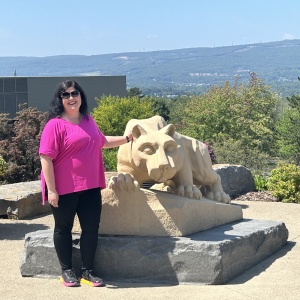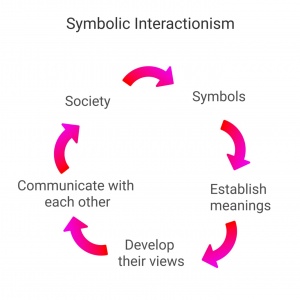
The #ItalianAmerican community and social media, metaverse and artificial intelligence
La comunità #ItalianAmerican e i social media, il metaverso e l'intelligenza artificiale

While in 2024 We the Italians took its first steps into the metaverse and the use of artificial intelligence, one of the innovations of 2025 for us will be a more effective and comprehensive approach to social media. We look at new technologies and the future with curiosity, interest and confidence.
There is one person in the Italian American community who has written books about Italian American traditions and communities in her state, Pennsylvania (where she is also our Ambassador...), and yet for some time now she has also been an expert on the use of new technologies in communicate and represent the Italian American identity. Stephanie Longo is also a very dear friend of mine and one of the best people I know. There is no better way to end the year 2024 of my interviews!
Dear Stephanie, welcome back to We the Italians! First of all, for our friends who don’t know you, please tell our readers something about you
Ciao, my friend! Thank you so much for having me back on We the Italians, it is an honor! For those who don't know me, I am a very proud Italian American, and my ancestral homelands are Guardia Lombardi (Avellino, Campania) and Lamezia Terme (Catanzaro, Calabria). My grandfather, Joseph Anthony Longo, came to the United States from Guardia Lombardi in 1927, while my grandmother Anna Mascaro Longo's parents came to the United States from Lamezia in 1907. This past summer, I was named a cultural ambassador of Irpiniaby DMO Irpinia. Being Irpinian is extremely important to me, and in my spare time I write a blog about Irpinia called "Irpinia Stories."
Among the many things I’ve done, I was the Associate Producer at the Italian American Podcast from 2020 until 2023. Now I am an assistant professor of Corporate Communication at Penn State Scranton, which is also my hometown. I hold a Doctorate of Strategic Communication degree (2024) from Regent University, and I recently received the 2024 Memorial Fellowship Award from the Italian American Studies Association (IASA) for my dissertation, “Passing the Flame: Place Branding, Destination Marketing,and Ancestral Tourism.” I am extremely proud of this award because it was the first time my academic work was recognized on such a wide scale, and it is especially meaningful because this award comes from Italian American researchers and scholars that I have looked up to over the course of my career.
I find very interesting and innovative your paper called "eEthnicity: Social media, Italian Americans, and Cultural Identity". What is the relationship between social media and various generations of the Italian American community?
Italian Americans are both passionate and proud of their ethnic heritage, and social media is one realm where they can express and experience their culture in various ways. The results of this study published as part of “eEthnicity: Social Media, Cultural Identity, and Italian Americans” show that there are slight generational differences when it comes to the tangible experience of ethnic heritage on social media as a user determines what content is most effective as an educational and informative tool.
Presenting social media as a new host culture for Italian Americans where their ethnic identity serves as their primary point of reference as they navigate the digital world, the study that served as the basis for “eEthnicity” attempted to determine exactly how effective social media can be as a tool for discovering and learning more about one’s ethnic heritage.
I personally think the results of this study are important for Italian American organizations to examine because studies have shown that different generations, regardless of ethnicity, are attracted to different types of social media posts. What I attempted to do with “eEthnicity” was figure out which posts were more relevant for specific generations of Italian Americans. I should warn, though, that if an organization wants to apply these results to its membership, it should first take into account not only the generations that comprise its membership, but also the generations that might be following it on social media because these two audiences may differ. I would also suggest that Italian American organizations examine the generational breakdown of their social media followers based on platform, as studies have shown that different generations prefer different platforms.
For example, according to Choudhury (2022), Millennials tend to prefer Facebook, but Generation X and Baby Boomers tend to gravitate toward YouTube, while Gen Z tends to prefer Instagram. Respondents were described as members of the Baby Boomer generation, Generation X, Millennials, or Generation Z based on the criteria presented by the Pew Research Center (Dimock, 2022). Traditionally, anyone aged 55-73 would be labeled as Baby Boomers, while Generation X would be labeled as age 39-54. Those aged 23-38 would be labeled as Millennials, and respondents aged 22 and younger would be labeled as Generation Z (Dimock, 2022). Because of the overlapping of generations due to the age brackets presented to respondents, those who answered that they were age 60 or older in the survey were labeled as “Baby Boomers,” while those whose ages range from 41-59 years old were labeled as “Generation X.” Respondents aged 30-40 were labeled as “Millennials,” and respondents up to age 29 were labeled as “Generation Z.
”The study presented in “eEthnicity” partially corroborates Choudhury’s results, as the only respondents to cite YouTube as a preferred platform were either Baby Boomers or Generation X. Generation Z respondents to this study also ranked Instagram as their favorite social media platform.
Do different types of social media posts affect Italian Americans differently depending on their age?
Absolutely! As I wrote in “eEthnicity,” photos with captions were labeled by all generations as the most effective type of social media posts for them to learn more about their heritage, but there was a generational disparity in terms of what the least effective type of social media post was for them to discover more about their heritage. Both Generation X and Generation Z found longer-form videos lasting five minutes or more to be least effective, while Millennials and Baby Boomers felt that short, text-based posts without images were least effective. Interestingly, both Gen Z and Baby Boomers want to see more posts directing them to pertinent websites to get more information, while Generation X and Millennials wanted to see more short-form video content.
The results of this study prove that an organization can’t have just one social media strategy and hope that it attracts everyone—different generations respond to different types of posts, so a multifaceted marketing approach is necessary if Italian American organizations wish to see growth on social media that will then, hopefully, translate into membership growth. There is no “one-size-fits-all” when it comes to social media and marketing, Italian American organizations need to be strategic when coming up with a social media campaign, and they need to take the differing needs and differing attention spans of the different generations into consideration to see success.
How effective social media can be seen as a tool for discovering and learning more about one’s ethnic heritage?
The people who answered the survey presented in “eEthnicity” showed a strong cultural tie to their Italian American heritage that affected their personal identity to the point where they felt it was necessary to seek out Italian American-related content on social media. By participating in Italian American social media sites as either a fan or consumer of content, the respondents showed a social identity in which both their cultural and personal identities play a defining role. While personal identities may differ due to generational differences, among other things, the respondents still culturally and socially belong to their Italian American heritage, and that is the lens through which they are interacting with Italian American-based social media content.
Symbolic interactionism theory as described by Chen (2019) played a major part in how the respondents to the survey in “eEthnicity” responded to heritage-based social media content. Chen (2019) explained that a technology may represent radically different meanings to users across different social contexts and for different purposes. For this study, the respondents’ cultural identity was used as the social context within which they operate. Respondents showed that their cultural identity does influence how they interact with social media content; for example, some felt that they experienced ethnic discrimination online due to their ethnicity when, possibly, the original poster did not mean this to be the outcome. Generational differences did occur at times when interacting with ethnic-based content, especially in terms of which content was least effective as an educational tool for discovering more about one’s heritage. This could also be applied to symbolic interactionism theory because users are going to engage with the content they feel is most appropriate for their needs; a short video may be more appropriate for some users, while posts suggesting a user access another website for more in-depth information may be more beneficial to others.
However, I also want to add that good content is good content. Effective social media content works regardless of generational differences. The respondents to this survey showed that their cultural heritage is something they feel from within, meaning that no social media content will influence what they believe to be true. If a person is proud of his or her ethnic heritage, that pride will carry through no matter what outside sources may say.
Another very interesting paper you wrote is called "Hashtags and Heritage: The Use of #italianamerican on Instagram". Please tell us more about this.
“Hashtags and Heritage: The use of #italianamerican on Instagram” shows that Italian Americans use social media to educate others about their heritage, as well as to celebrate their culture of origin. The basis for this paper was a content analysis of 50 Instagram posts that contained the hashtag #italianamerican.
Social media is a place where users can express themselves freely while meeting people who share similar interests. This particular study sought to begin a conversation on how cultural identity is expressed on social media and to determine if social media is a new type of ethnic digital neighborhood where users can exchange ideas, meet people from similar backgrounds, and educate users who do not share their same ethnicity. By examining how one culture, in this case, the Italian American culture, avows itself online, it is clear that its ethnic identity transfers to the digital sphere.
The use of ethnic-based hashtags, such as #italianamerican, allows for the beginning of an ethnic digital neighborhood, as the hashtags serve to collect posts made by similar-minded individuals that can then open a broader conversation about ethnic culture, highlighting well-known occurrences such as the Feast of the Seven Fishes as well as teaching people about lesser-known topics, such as All Saints and All Souls Day observances. The more strongly a poster identifies with his or her ethnic culture and the more strongly the poster is familiar with that specific culture, the stronger the message his or her post conveys about the culture in question. As also seen in this study, the digital ethnic neighborhood is an inclusive environment where users can engage with a post simply out of curiosity, regardless of ethnic background.
Thus, potential cultural beliefs or tendencies have the opportunity to become known by a wider audience, transcending ethnic and cultural boundaries. The selected comments presented for this study also underscore this point, as users were seeking to engage and interact with the original posters, all of whom had something deemed intriguing about Italian American culture. As these digital ethnic neighborhoods are just beginning to be studied, it can be assumed that these communities allow users to strengthen their ethnic ties because they are able to express ideas, meet other people of similar ethnic backgrounds, and discover more about their heritage from trusted sources.
In the case of #italianamerican, the digital neighborhood experience was positive. While one ethnic group’s experience cannot be fully applied to another, because these digital neighborhoods are filled with people seeking similar experiences, it stands to reason that other ethnic groups will also reap positive benefits from participating in them, even if that participation is minimal. I specifically wanted to study Italian Americans because even though they are not traditionally seen as people of color, they represent a viable ethnic group that is worthy of future study.
We the Italians is very interested in how the future forms of communication and information will be able to shape and improve how the Italian Americans will feel about themselves and how they will maintain their relationship with their Italian roots. Talking about this, what is your thought about the Metaverse, Extended Reality and Artificial Intelligence?
These topics are extremely important, as the communication world is moving rapidly in this direction. In my dissertation, “Passing the Flame: Place Branding, Destination Marketing, and Ancestral Travel,” I discuss at length the application of the Metaverse, extended reality, and artificial intelligence to the world of Ancestral Travel, also known as Roots Tourism.
In my dissertation, I advocate for the creation of a subfield of Destination Marketing called “Ancestral Homeland Marketing” because my study proves that ancestral travelers are their own separate category of place consumers and need to be treated as such. One such way ancestral travelers can be marketed through is via the addition of augmented reality tours of ancestral towns in Italy. These travelers may not be as interested in seeing what the town looks like today, but they would want to know what it looked like when their ancestors lived. An augmented reality tour could demonstrate what the town looked like back then while giving the traveler the physical experience of returning to their ancestral homeland. Also, artificial intelligence could help reconstruct family photos based on the physical descriptions of an ancestor that are often found in town documents. Artificial intelligence can also help ancestral travelers to Italy who may not speak Italian through instant translation and interpretation services.
My entire concluding chapter discussed these uses because the possibilities are endless. I am looking forward to hopefully publishing the results of my dissertation soon in an academic journal and would love the opportunity to collaborate with researchers in Italy who are studying these phenomena, as it is a conversation that needs to continue from both the ancestral homeland perspective and the perspective of the ancestral traveler. I focus my research on the perspective of the ancestral traveler and am finding that this particular audience isn’t being studied as much as it should be, even though they have wants and needs that are much different from traditional travelers because they feel as if they are “home” when visiting their ancestral homelands, even though they may never have lived there before.
I also think that Italian American organizations should harness these developing technologies now so they are on the cutting edge of these trends. For example, artificial intelligence can be used to create an image that can then be posted to social media, which can save time and money if an organization is operating on a shoestring budget.
I do want to caution that artificial intelligence can be dangerous if it is used incorrectly—a social media post that is created with AI should be labeled as such, and anyone who operates as a public figure should consider the possibility of deepfakes, as the potential for an AI crisis is strong. However, the benefits of AI do outweigh the risks. I always tell my students that it is okay to experiment with it, but don’t make it the crux of your work as people can tell if you’re only relying on AI to construct your messages. AI can be an assistant, but there’s no substitute for human knowledge and human creativity.
You may be interested
-
Ethnic clubs are fading into Beaver County's...
By Tom Davidson When Dominic "Hawk" Santia was a boy, he'd tag along with his fat...
-
I Piccoli Cittadini: incontro di educazione...
Saturday, October 24, 10-12 AM in EDT, 1026 Public Ledger Building – 150 South Indepe...
-
Italian restaurant opens in Conewago Townshi...
by Melody Asper Hanover's newest restaurant may seem like an old friend to anyone...
-
Mostaccioli: The Calabrese Christmas Gingerb...
Here in our home, one of our Christmas traditions is making gingerbread cookies and one gi...
-
President and CEO of Furia Rubel Elected Jus...
Furia Rubel Communications, Inc., an award-winning integrated and strategic marketing and...
-
`Otello,' Rossini's not Verdi's, staged in Ph...
Rossini’s “Otello” premiered in 1816, and the musical adaptation of Shakespeare's famous p...
-
'A silver lining': Gran Caffe L’Aquila finds...
Philadelphia’s Gran Caffe L’Aquila is no stranger to tragedy. In fact, the landmark Italia...
-
'A Ziarella va in America: tournèe in Arizona...
‘A Ziarella va in America. Non è un titolo da film, ma una piacevole realtà. Il...




























